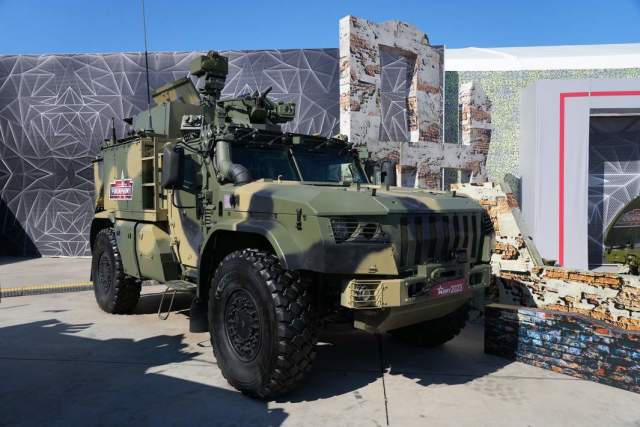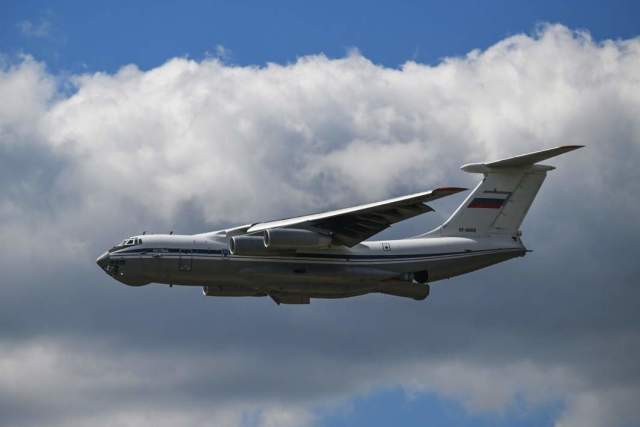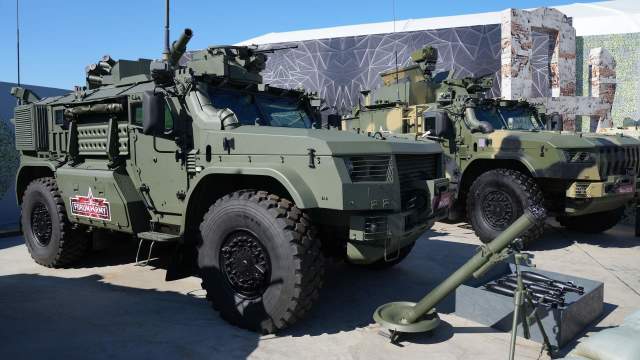Artillery of the Armed Forces of the Russian Federation will seriously increase firepower and combat capabilities
New highly mobile artillery systems are in demand in a special military operation, their development is carried out by enterprises of the Russian military-industrial complex. They were shown at the Army-2023 forum, and the Ministry of Defense signed contracts for the supply of the Armed Forces of Russia. Izvestia, together with a military expert, the founder of the Military Russia portal Dmitry Kornev, understood what kind of systems they are, what capabilities they have and how they will change the situation in the SVO zone.
Small "Drok"
For the first time at the Army forum this year, the 82-mm self-propelled mortar complex 2C41 "Drok" was shown, which was created by Rostec enterprises on the basis of a two-axle armored vehicle "Typhoon-Airborne". Only a month ago, the first batch of new complexes was transferred to the troops for trial operation.
A self-propelled mortar in a special turret with circular rotation is mounted on a high-terrain chassis. This is a highly mobile artillery system, for the use of which the crew does not need to leave the reserved volume. The reservation protects the crew from shell fragments and small arms bullets. The chassis design is made taking into account the protection of fighters when mines are triggered. All this provides the installation with the ability to get out from under the blows and perform a fire maneuver on the front line of defense or accompany the advancing units in the offensive.

82 mm self-propelled mortar complex 2S41 "Drok"
Image source: Photo: IZVESTIA/Dmitry Korotaev
The artillery part of the new mortar has also been improved. The aiming range of the "Drok" has been increased by more than one and a half times compared to conventional 82 mm 2B14 "Tray" mortars. The range of fire is up to 6 km. The rate of fire of the mortar built into the turret is 10 rounds per minute, that is, a new shot every six seconds. The standard ammunition of the combat vehicle is 40 rounds. By the way, for defense, the self-propelled complex is also equipped with a 7.62 mm machine gun.
The purpose of such a self—propelled mortar is the destruction of manpower and lightly armored enemy equipment, work on observation posts and the creation of smoke screens with special mines. The complex is equipped with a digital control system that facilitates the guidance of the mortar on the coordinates of the target and significantly accelerates its defeat. There is no need to deploy the mortar in a combat position, and this significantly saves time — the machine can fire without preparation and from any stop.
Highly mobile complexes with protected calculations, of course, are in demand in the area of the SVO and are necessary for the ground forces.
Self-propelled "Malva"
The 2C43 Malva howitzer, first shown to the general public, became a large caliber of the Army-2023 wheeled artillery. This year, its military tests are being completed, and already at the forum, the Russian Ministry of Defense signed a contract with Rostec State Corporation for the supply of these self-propelled artillery units (ACS) to the armed forces. Factory tests were carried out in 2021, and the installation itself was created by the Central Research Institute "Burevestnik" (part of Uralvagonzavod). The artillery part of the installation is a 152 mm howitzer. The chassis is a four—axle all-terrain vehicle BAZ-6910. The mass of such a combat vehicle is 32 tons .

Howitzer 2C43 "Malva"
Image source: Photo: IZVESTIA/Dmitry Korotaev
Today, the Malva installation uses a type 2A64 howitzer, the same as in the Msta self-propelled gun. This removes a lot of maintenance issues and the organization of mass production. The development of a modernized artillery unit with an increased range has already begun for the Malva. The ammunition carried is 30 rounds. The main objectives of such an installation are enemy command and support points, warehouses, fortifications, artillery and missile batteries, areas of concentration of enemy equipment and personnel.
Why is there such an interest in wheeled self-propelled artillery? In addition to the global trend, there are really serious arguments. There are two main factors here: the cost of operation and high mobility in conditions of a long front. Tracked self-propelled units can accompany tank military units in an offensive over rough terrain, but wherever there are roads, it is easier and cheaper to make do with cars. Moreover, armored artillery corps are not always needed — as a rule, gunners with howitzers perform their combat work not on the front line of defense, but in the rear.
The ACS 2C43 "Malva" is airmobile, that is, it can be transferred by military transport aircraft. Moreover, to transfer to another theater of military operations, she does not need a heavy transport aircraft An-124 "Ruslan". These self-propelled guns can be transported by more massive IL-76 aircraft, which significantly increases the capabilities of the armed forces to transfer self-propelled artillery anywhere.

Il-76 aircraft
Image source: Photo: RIA Novosti/Maxim Blinov
The speed of movement and deployment time also serve as bonuses of the new self-propelled installation. The range is 800-1000 km, which is almost twice as long as that of tracked analogues. Of course, digital control systems provide acceleration of gun guidance and new modes of operation. This was the mode of the "simultaneous fire raid" type for the "Mallow" — this is when several shells fired sequentially due to automatic changes in the angle of inclination of the gun hit the target almost simultaneously. The rate of fire of the new ACS is more than seven rounds per minute.
Today, the Malva is undergoing military tests, but the need for such a combat system is obvious, and the installation has already been put into serial production. At the same time, work on modernization has also begun — this is an ongoing process in artillery. It is expected that this will not only give the gunners additional properties of self-propelled guns, but also by switching to a new artillery system will increase the range. And then Malva, in principle, will have no equal in the counter-battery struggle.
Dmitry Kornev

